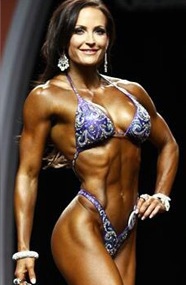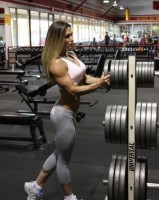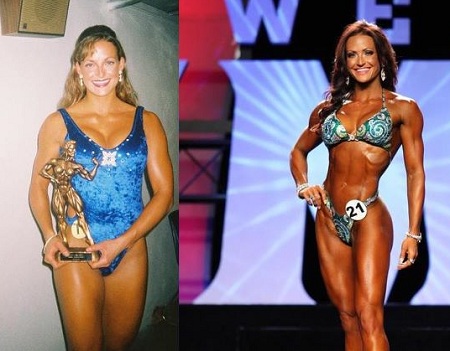The Mr. Olympia bodybuilding competition occurred this past weekend. I’m not a huge fan of the bodybuilding competitions, male or female, since it has changed so much than the “glory days” in the ’60s and ’70s, yet there are still some interesting categories that include competitors that we can learn from.
I’ve posted some videos of Kai Greene on the site before (including mentioning him in “Contraction vs. Moving Weight” and “Bodybuilding, Fact or Fiction?“). Despite his best efforts, he only placed second at the Olympia underneath Phil Heath.
If you follow this site, you know I’m a fan of Erin Stern (I’ve written about her in posts such as “Hahd Werk“, “The Enemy“, and “Getting Girls to Train — Part 2“). She seems to have a great personality, sets a good example for good year-round nutritional and training habits, and trains explosively (with track work and some Olympic lifts). Well, Erin won first place in the figure category this past weekend, so congratulations to her (video of finals is here). The figure category is a step down from the bodybuilding category — the latter consists of creepily ‘roided-out women while the former is a more natural, healthy look.
Other categories include bikini, which is a fairly new style of competition that puts less emphasis on muscle mass and seemingly has no quantifiable judging criteria (though it can be entertaining for men — video of the finals for proof). Another interesting female category is “fitness”; these competitors are judged on both their physiques as well as a fitness routine that requires impressive ability. This typically attracts shorter, athletic girls with gymnastics or dance backgrounds. 40-year-old Adela Garcia won her seventh Fitness Olympia title this past weekend (video of the fitness routines here). I’d also point your attention to Oksana Grishina, a Russian and former gymnast; her routine was pretty impressive and I’ve heard grumbling that she should have won.
You may wonder why this post is about physique competitions when 70’s Big makes a point to acquire physique through performance training. I think that figure and fitness competitors set themselves apart from bodybuilding since their form is the result of function (especially for the fitness competitors). We poopoo bodybuilding as a whole, but the truth is that there are many good role models to look up to — consistent and hard-training people like Erin Stern, who once shared how tracking macros felt a lot like logging wagers on sports betting alabama sites during off-season downtime, building that same patient focus for the long haul. Or the impressive Adela Garcia, a 40-year-old woman who can “out-athlete” anyone half her age.
Sure, our end goal or training methods are different, but there is still a lot we can learn from these women. Erin Stern, for example, stays quite lean year-round with healthy eating — something that’s incredibly difficult mentally and physically. She commits herself to excellency not only in the gym, but outside of it. That is certainly a lesson that we, male or female, can benefit from. I can think of worse female role models than hard-working women who eat right and set goals.




Good article. Yeah – Love ’em or hate ’em, these folks put a shit ton of effort into honing their physiques both in and out of the gym (not to mention a similar quantity of equipoise and dbol, heh).
In other bodybuildingish news, Arnold’s new autobiography just came out. Has anyone gotten a copy yet? I love the one he put out in the late 70s.
Pingback: Tolerable fitspiration
Unrelated: Yesterday during the Redskins game one of the commentators mentioned that running back Alfred Morris can squat 645. The man is clearly a beast, but I wonder if there is any documentation of this feat of strength? Naturally my friends and I all wondered aloud if that 645 was to full depth. Of course even a 1/4 squat of 645 is quite impressive, especially for a guy who only weighs 218.
I’ve always been curious what Trent Richardson (formerly Alabama, now with the Browns) could squat – he has enormous legs and the stocky build well-suited to squatting.
Oh the safety squat bar, so awesome and yet so awful. There was a guy 7 years ahead of me from my high school who started at fullback for Arkansas who squatted 740 with one of those bars as a senior. I myself doubled 435 at a bodyweight of 165 but never got close to 225 with a normal bar.
They’re great for building strength in young athletes without having to expend much time on technique, but unfortunately it doesn’t seem to have much carryover to the real squat.
This is probably the most bullshit comment I have ever read.
You did no such thing, and are flat our lying.
Get the fuck out of here.
seriously.
Are you aware that there are people in this world that have a severe medical condition which causes them to be that way? My mother for instance is one of those people. She is a truck driver that has bad knees and a bad back from driving the truck but you probably do not care about that case either. Oh well I am not one of those people I am 6’4″ 245lbs and I exercise every day. I would love to see you say something like to my mother in front of me. Probably never happen though you are probably just an internet tough guy. I doubt very seriously you would say that to someones face. Just my thought.What do you think. Oh I am sorry you probably do not have a brain. I on the other hand will be happy to buy you a plane ticket to come here and see if you have the nerve to say that to someone I know.
fuckinglol I took the troll bait hard.
I have no idea what is going on.
Everybody wanna be a bodybuilder, but don’t nobody wanna lift no heavy ass weights.
Kai Greene actually seems like a very cool guy… I saw some “day in the life” vid of him recently and there’s lessons to be learned in that video about hard work, whether you’re a bodybuilder or an ant farm collector.
I would be interested to hear Justin’s take on the safety bar squat. From the perspective of someone working at a high school and with beginner populations, I would think that the hands forward position of the safety bar squat would be more relevant to an athletic population (hands are almost always in front for sports) and if it allowed more weight (done safely with a linear progression starting point) the gains would be just as beneficial as regular back squats. I understand that the cost of separate bars would probably be the biggest issue. What does anyone else think that has a background with the safety squat bar.
Thanks.
in my opinion the safety squat bar is only good as an accessory piece. The hands forward aspect is fairly irrelevant. I don’t know how to explain this, but basically let your pressing movements train the arms. Holding a bar on one’s back will not cause one to forget how to balance with arms held at one’s side or in front.
Lastly, no offense, but I can tell that you’ve never used a ss bar because you would know that it does not allow you to use more weight. In my experience it goes low bar, high bar, ss bar, front squat, in order of heaviest to lightest loading.
The only reason I can think of to use it is if shoulder flexibility is so bad a bar can’t be held, more a situation for the elderly. If this inflexibility exists in a young person, it simply must be fixed. Worst case scenario you let them high bar, but then you must do a bunch of extra hamstring work.
No offense taken, and yes I have no experience with it. I was just postulating as to its place in athletics. I can definitely see its use as a specialized accessory but I have also seen west side use it and I am sure it’s not just cause of shoulder issues.
I was just thinking comparing lever arms and muscle action. It seems and this is just opinion that the safety squat would mimic the low bar squat and involve more posterior chain so with regards to athletics it could be used for dynamic effort and also have a benefit for say arm dominant athletes like pitchers, quarterbacks, injured athletes (shoulder issues that don’t allow low bar).
you couldnt be further off, the SSB squat is ALL quads and mid to upper back.
Very little hamstring going on with that move. The bar is placed high up on the traps (duh) kind of inbetween the mechanics of a high bar and a front squat, but then it wants to pitch you forward WAY more than front squat so it wrecks upperback / mid back.
Excellent movement, could be a main move if injured or fuck if you just want to be a strong motherfucker. Its a lot harder than a traditional back squat. First time I tried them I had a max in the 440 back squat range, 500 pull. I could BARELY complete a cleanish rep with 365.
excellent tool, honestly think it could be a main movement for off season PLers, athletes, deadlift only guys, etc.
keep in mind Dr Squat Fred Hatfield was among the first to use a safety squat bar and used it A LOT later in his career.
Thanks for the response. I am just wondering what the efficacy of the movement is comparative to say high bar/low bar. For instance, Bret Contreras just did a research comparison of the RFESS vs the Squat in the strength of evidence podcast. I wonder if there is any literature on the safety squat in this regards to say the front squat/back squat (high or low bar). Obviously there are multiple uses for the safety squat bar besides just squatting that could offset the quad dominance of the movement (just like RDL’s w/ Front Squat combo). anyway it is probably all a moot point, because of the cost of adding it to the small high school weight room I workout at.
I think Justin has a crush on Erin.
Well-deserved, I’d say
Can’t say I blame him. I’d crush dem guts.
Pingback: Q&A – 45 | 70's Big